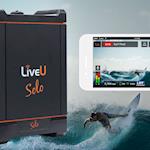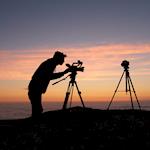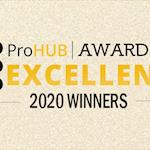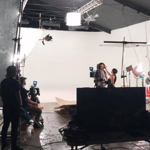With in-person concerts on hiatus, Grammy-nominated rock band Underoath turned to Odd!Life Studios to help produce a live streamed concert series so fans could enjoy their music while at home. Creating an immersive experience that was equal parts performance art, the concert series (“Underoath: Observatory”) consisted of three concerts over the course of three weeks, with each concert covering one of Underoath’s albums in its entirety.
Cinematographer, Director and Producer Lief Thomason from Odd!Life Studios spoke exclusively to us about what it took to successfully pull off the concert series, including how using a Blackmagic Design workflow powered by four Pocket Cinema Camera 6Ks, an ATEM Mini Pro, ATEM 2 M/E Production Studio 4K and ATEM 1 M/E Broadcast Panel helped them get everything done within their tight two week turnaround time.
PH: When Underoath approached Odd!Life Studios to pull off a concert series in the current climate, what was going through your head?
Lief Thomason: Safety was at the top of everyone’s mind. Some of the band and crew had to fly in when Florida was seeing a rise in COVID-19 cases, and everyone wanted to ensure all protocols were followed. Of course, I’m also thinking about my team. I brought in five people that needed to be there three weeks in a row. If any of them came down with symptoms or came into contact with someone with COVID, I would have been scrambling to find more crew members. That was honestly super stressful. On top of that, we needed rentals and extra gear and had to ship it all in. At the time, everything was taking way longer to ship and we definitely cut some deadlines close.
PH: What did the pre-production process look like?
Lief Thomason: From the time I was brought to the project, we had basically two weeks until the first streaming night, so I spent a couple of days talking to the creative leads on the project to first get an understanding of the vision for Observatory. Originally, we had this idea for a four-camera operation with three cameras positioned in different thirds of the round and the iconic birds-eye shot, but it evolved quickly. We were determined to capture the energy of live music with this cinematic twist, drawing inspiration from a few different music video performances. In the end, I just couldn’t see pulling off the vision and selling the round with less than eight cameras. Once I understood the vision, I had to start gathering equipment. Our company has operated in broadcast, commercial, short narrative, and documentary productions, so live stream equipment is not our specialty, which meant we had to rent and borrow from a lot of places to get everything necessary. It was wild and I am enormously grateful to everyone who helped us piece-meal this to pull it off.
PH: What was your creative thought process and how did you ensure it was also safe?
Lief Thomason: The vision from the creative leads began with three camera operators. We needed a way to capture Underoath's energy but also have some variation in style that matched with the changing pace from song to song. I decided to go with an operator on a shoulder rig and another on a gimbal. As I got to thinking about the round, I had this idea to create a camera with a “pit view” to simulate an audience perspective from a pit that also emphasized the round. For this, we put the third operator on a tripod at the center with a wide-angle lens, and his role was to create energy through a series of whip pans and create a few cool silhouettes of band members. From there, I began to look for some safety shots that I knew I could always default to while doing the live edit. Of course, health was also at the front of our minds. We implemented all the same basic procedures for a safe workplace: providing masks for all crew to wear at all times, sanitizer all around the room, and distancing when possible. Since audio, lighting, and video were all stationed in different parts of the facility, we had another unique challenge of getting a clear, strong video signal to all departments plus a source for our LD. He was working remotely and needed to see how the design was responding in the room during rehearsals so adjustments could be made in real time. It’s hard to get frustrated by all of the unexpected challenges that come with the times since the project was one big experiment in how to overcome challenges of live music during a pandemic. At all points, we just accepted obstacles and collaborated on the best solutions available to us, and it worked.
PH: Were there any challenges - and how did you address those?
Lief Thomason: I can’t stress enough how every decision I was making had to come back to the options I would have when switching live. We all knew from the beginning that if we were going to bring energy, it would have to come from the rhythm of the switch, treating it more like a live edited music video than a traditional live performance. I needed safety shots on tripods that would let me showcase more instruments, vocalists, and features of the round. My personal inspiration for these shots came from Kanye West’s Sunday Service. I was captivated by a few shots from that performance and it inspired me to look for unique angles with lots of depth and dynamic movement in the lights and band members.
PH: Can you talk a bit about the Blackmagic Design equipment you used?
Lief Thomason: When we looked into cameras for the Observatory project, we needed something small and light, with professional monitoring solutions for camera operators like zebras and focus peaking, a minimum of 4K internal recording, good colors right out of the camera, and they needed to be affordable. Knowing Blackmagic Design's track record in live streaming, the Blackmagic Pocket Cinema Camera 6K was an easy choice. The cameras communicate easily with Blackmagic Design's switchers and also enabled us to get 1080p 23.976fps for the cinematic look of these live music video concerts. When combined with the Micro Converters HDMI to SDI, we were able to run SDI into the larger ATEM 2 M/E Production Studio 4K for our eight-camera warehouse setup. We also had many teams working together that all had unique monitoring needs coming out of our switcher. The ATEM 2 M/E Production Studio 4K offers six programmable aux outputs in addition to 2 M/E and multiview out, giving us the flexibility to send program monitors to lighting and audio departments while getting a multiview monitor for ourselves. We also needed eight camera inputs over SDI to cover the distance from the Observatory round stage to our switching station, an easy task for ATEM 2 M/E Production Studio 4K. When paired with the ATEM 1 M/E Broadcast Panel, we had a robust system for the demanding live-edit music video style for the concert, complete with good tracking distance on the switcher keys for decisive selections and an easy-to-use preview keys and t-bar fader for the occasional smooth transition.
PH: How did it allow you to get everything done with a tight deadline?
Lief Thomason: The most helpful thing was having local rentals available for the equipment. It was a really short time frame to get this gear together and shipping times were all held up. I can’t talk up enough how easy and seamless the Blackmagic Design gear is for first time users. Setup was super easy and learning the ATEM Software Control took no time. The board was intuitive, and the image out of the cameras is so nice that we didn’t have to do any fine-tuning for the concerts.
PH: In general, how do you navigate tight deadlines while still ensuring quality work?
Lief Thomason: I’m sure my default is roughly the same as everyone: just put in the time. I had to spend many late nights getting equipment and process sorted out the week leading up to the streams so that I knew the workflow from setup to stream. I basically felt on pace at the end of each night and that was enough, never ahead of schedule and never behind. The next part was good communication and collaboration. I kept in contact with the tech and creative leads on the project to keep a pulse on the vision at all times. We attended rehearsals, ran test streams, and skimmed through footage from dress rehearsals to keep checking for opportunities to improve the process and give my ops room to grab great shots so that I had as many options as possible while live editing. I think the success for our part of the project always came down to ensuring we were maximizing usable shots for the switch.
PH: Do you foresee concerts leaning more into live streaming in the future? How do you think the way we view concerts will change?
Lief Thomason: I guarantee live streaming like this is here to stay. There’s so much opportunity for bands and venues to use this for fresh content and unique engagement with audiences and fans. Live streaming will not replace live music, but the two can benefit each other for sure. Imagine bands doing tour kickoffs with a live stream or featuring new albums, getting fans excited for tours and giving bands a way to engage in a unique way with audiences in even the most remote parts of the world.
About Lief Thomason
Lief Thomason is a filmmaker from central Florida and the owner of video production company Odd!Life Studios. He has worked as director of photography on award-winning short films, managed creative on many broadcast campaigns for businesses throughout central Florida, and was recently highlighted in Forbes for his work on Observatory, a live streaming performance-art concert series by Tampa based, Grammy-nominated band, Underoath. His passion remains in the arts and technology, looking for unique ways to marry visual arts with other mediums to tell compelling, interactive stories.











Comments
There are no comments on this blog post.